Solvent-Tuned Synthesis of Mesoporous Nickel Cobaltite Nanostructures and Their Catalytic Properties
Abstract
:1. Introduction
2. Materials and Methods
2.1. Sample Preparation
2.2. Sample Characterization
2.3. Catalytic Activity Test
3. Results and Discussion
3.1. Morphology, Microstructure, and Composition Characterizations
3.2. Catalytic Activities
4. Conclusions
Author Contributions
Funding
Conflicts of Interest
References
- Tan, C.L.; Cao, X.H.; Wu, X.J.; He, Q.Y.; Yang, J.; Zhang, X.; Chen, J.Z.; Zhao, W.; Han, S.K.; Nam, G.H.; et al. Recent advances in ultrathin two-dimensional nanomaterials. Chem. Rev. 2017, 117, 6225–6331. [Google Scholar] [CrossRef] [PubMed]
- Dong, C.Q.; Kou, T.Y.; Gao, H.; Peng, Z.Q.; Zhang, Z.H. Eutectic-derived mesoporous Ni-Fe-O nanowire network catalyzing oxygen evolution and overall water splitting. Adv. Energy Mater. 2018, 8, 1701347. [Google Scholar] [CrossRef]
- Liu, D.L.; Zhang, C.; Yu, Y.F.; Shi, Y.M.; Yu, Y.; Niu, Z.Q.; Zhang, B. Hydrogen evolution activity enhancement by tuning the oxygen vacancies in self-supported mesoporous spinel oxide nanowire arrays. Nano Res. 2018, 11, 603–613. [Google Scholar] [CrossRef]
- Bhagwan, J.; Nagaraju, G.; Ramulu, B.; Sekhar, S.C.; Yu, J.S. Rapid synthesis of hexagonal NiCo2O4 nanostructures for high-performance asymmetric supercapacitors. Electrochimi. Acta 2019, 299, 509–517. [Google Scholar] [CrossRef]
- Du, X.Q.; Shao, Q.Z.; Zhang, X.S. Metal tungtate dominated NiCo2O4@NiWO4 nanorods arrays as an efficient electrocatalyst for water splitting. Inter. J. Hydro. Energy 2019, 44, 2883–2888. [Google Scholar] [CrossRef]
- Jain, A.; Paul, B.J.; Kim, S.; Jain, V.K.; Kim, J.; Rai, A.K. Two-dimensional porous nanodisks of NiCo2O4 as anode material for high-performance rechargeable lithium-ion battery. J. All. Compd. 2019, 772, 72–79. [Google Scholar] [CrossRef]
- Ding, R.; Qi, L.; Jia, M.J.; Wang, H.Y. Facile synthesis of mesoporous spinel NiCo2O4 nanostructures as highly efficient electrocatalysts for urea electro-oxidation. Nanoscale 2014, 6, 1369–1376. [Google Scholar] [CrossRef] [PubMed]
- Karunakaran, G.; Maduraiveeran, G.; Kolesnikov, E.; Balasingam, S.K.; Viktorovich, L.D.; Ilinyh, I.; Gorshenkov, M.V.; Sasidharan, M.; Kuznetsov, D.; Kundu, M. Ascorbic acid-assisted eco-friendly synthesis of NiCo2O4 nanoparticles as an anode material for high-performance lithium-ion batteries. JOM 2018, 70, 1416–1422. [Google Scholar] [CrossRef]
- Samantara, A.K.; Kamila, S.; Ghosh, A.; Jena, B.K. Highly ordered 1D NiCo2O4 nanorods on graphene: An efficient dual functional hybrid material for electrochemical energy conversion and storage applications. Electrochimi. Acta 2018, 263, 147–157. [Google Scholar] [CrossRef]
- Saraf, M.; Natarajan, K.; Mobin, S.M. Multifunctional porous NiCo2O4 nanorods: Sensitive enzymeless glucose detection and supercapacitor properties with impedance spectroscopic investigations. New J. Chem. 2017, 41, 9299–9313. [Google Scholar] [CrossRef]
- Wang, Q.Y.; Jin, K.L.; Lv, Z.X.; Yang, D.; Xu, J.C.; Hong, B.; Wang, X.Q. Synthesis and pseudocapacitive performance of ordered mesoporous NiCo2O4 nanowires. Inter. J. Electrochem. Sci. 2018, 13, 11675–11683. [Google Scholar] [CrossRef]
- Khalid, S.; Cao, C.B.; Wang, L.; Zhu, Y.Q. Microwave assisted synthesis of porous NiCo2O4 microspheres: Application as high performance asymmetric and symmetric supercapacitors with large areal capacitance. Sci. Rep. 2016, 6, 22699. [Google Scholar] [CrossRef] [PubMed]
- Zhang, C.F.; Yu, J.S. Morphology-tuned synthesis of NiCo2O4-coated 3D graphene architectures used as binder-free electrodes for lithium-ion batteries. Chem. Eur. J. 2016, 22, 4422–4430. [Google Scholar] [CrossRef] [PubMed]
- Zhang, Y.Y.; Wang, J.X.; Ye, J.H.; Wan, P.P.; Wei, H.M.; Zhao, S.Q.; Li, T.F.; Hussain, S. NiCo2O4 arrays nanostructures on nickel foam: Morphology control and application for pseudocapacitors. Ceram. Inter. 2016, 42, 14976–14983. [Google Scholar] [CrossRef]
- Hao, C.; Zhou, S.; Wang, J.J.; Wang, X.H.; Gao, H.W.; Ge, C.W. Preparation of hierarchical spinel NiCo2O4 nanowires for high-performance supercapacitors. Ind. Eng. Chem. Res. 2018, 57, 2517–2525. [Google Scholar] [CrossRef]
- Marco, J.F.; Gancedo, R.; Gracia, M. Characterization of the nickel cobaltite, NiCo2O4, prepared by several methods: An XRD, XANE S, EXAFS, and XPS study. J. Solid State Chem. 2000, 153, 74–81. [Google Scholar] [CrossRef]
- Nguyen, V.H.; Shim, J.J. Three-dimensional nickel foam/graphene/NiCo2O4 as high-performance electrodes for supercapacitors. J. Power Sources 2015, 273, 110–117. [Google Scholar] [CrossRef]
- Sing, K.S.W. Reporting physisorption data for gas/solid systems with special reference to the determination of surface area and porosity. Pure Appl. Chem. 1985, 57, 603–619. [Google Scholar] [CrossRef]
- Guan, X.F.; Li, G.S.; Zhou, L.H.; Li, L.P.; Qiu, X.Q. Template-free approach to core-shell-structured Co3O4 microspheres. Chem. Lett. 2009, 38, 280–281. [Google Scholar] [CrossRef]
- Abdel-Wareth, W.; Xu, X. Particle size effect on ammonium perchlorate decomposition kinetics. J. Aerosp. Power 2012, 27, 1179–1184. [Google Scholar]
- Liu, Z.R.; Yin, C.M.; Kong, Y.H.; Zhao, F.Q.; Luo, Y.; Xiang, H. The thermal decomposition of ammonium perchlorate. Chin. J. Energ. Mater. 2000, 8, 75–79. [Google Scholar]
- Reid, D.L.; Russo, A.E.; Carro, R.V.; Stephens, M.A.; LePage, A.R.; Spalding, T.C.; Petersen, E.L.; Seal, S. Nanoscale additives tailor energetic materials. Nano Lett. 2007, 7, 2157–2161. [Google Scholar] [CrossRef]
- Vyazovkin, S.; Wight, C.A. Kinetics of thermal decomposition of cubic ammonium perchlorate. Chem. Mater. 1999, 11, 3386–3393. [Google Scholar] [CrossRef]
- Lang, A.J.; Vyazovkin, S. Effect of pressure and sample type on decomposition of ammonium perchlorate. Combust. Flame 2006, 145, 779–790. [Google Scholar] [CrossRef]
- Zhao, H.F.; Lv, J.; Sang, J.S.; Zhu, L.; Zheng, P.; Andrew, G.L.; Tan, L.H. A facile method to construct MXene/CuO nanocomposite with enhanced catalytic activity of CuO on thermal decomposition of Ammonium Perchlorate. Materials 2018, 11, 2457. [Google Scholar] [CrossRef] [PubMed]
- Zhou, H.; Lv, B.L.; Wu, D.; Xu, Y. Synthesis of polycrystalline Co3O4 nanowires with excellent ammonium perchlorate catalytic decomposition property. Mater. Res. Bull. 2014, 60, 492–497. [Google Scholar] [CrossRef]
- Zhao, Y.J.; Zhang, X.W.; Xu, X.M.; Zhao, Y.Z.; Zhou, H.P.; Li, J.B.; Jin, H.B. Synthesis of NiO nanostructures and their catalytic activity in the thermal decomposition of ammonium perchlorate. Cryst. Eng. Commun. 2016, 18, 4836–4843. [Google Scholar] [CrossRef]
- Wang, J.G.; Jin, L.N.; Qian, X.Y.; Dong, M.D. Preparation and catalytic activity comparison of porous NiO, Co3O4 and NiCo2O4 superstructures on the thermal decomposition of ammonium perchlorate. J. Nanosci. Nanotech. 2016, 16, 8635–8639. [Google Scholar] [CrossRef]
- Tang, G.; Tian, S.Q.; Zhou, Z.X.; Wen, Y.W.; Pang, A.M.; Zhang, Y.G.; Zeng, D.W.; Li, H.T.; Xie, C.S. ZnO micro/nanocrystals with tunable exposed (0001) facets for enhanced catalytic activity on the thermal decomposition of ammonium perchlorate. J. Phys. Chem. 2014, 118, 11833–11841. [Google Scholar] [CrossRef]
- Jia, Z.G.; Ren, D.P.; Wang, Q.Z.; Zhu, R.S. A new precursor strategy to prepare ZnCo2O4 nanorods and their excellent catalytic activity for thermal decomposition of ammonium perchlorate. Appl. Surf. Sci. 2013, 270, 312–318. [Google Scholar] [CrossRef]
- Ninan, K.N. A thermogravimetric study on the catalytic decomposition of ammonium perchlorate from activation energy normalized through kinetic compensation. Indian J. Chem. 1998, 37A, 295–302. [Google Scholar]
- Guan, X.F.; Li, L.P.; Zheng, J.; Li, G.S. MgAl2O4 nanoparticles: A new low-density additive for accelerating thermal decomposition of ammonium perchlorate. RSC Adv. 2011, 1, 1808–1814. [Google Scholar] [CrossRef]
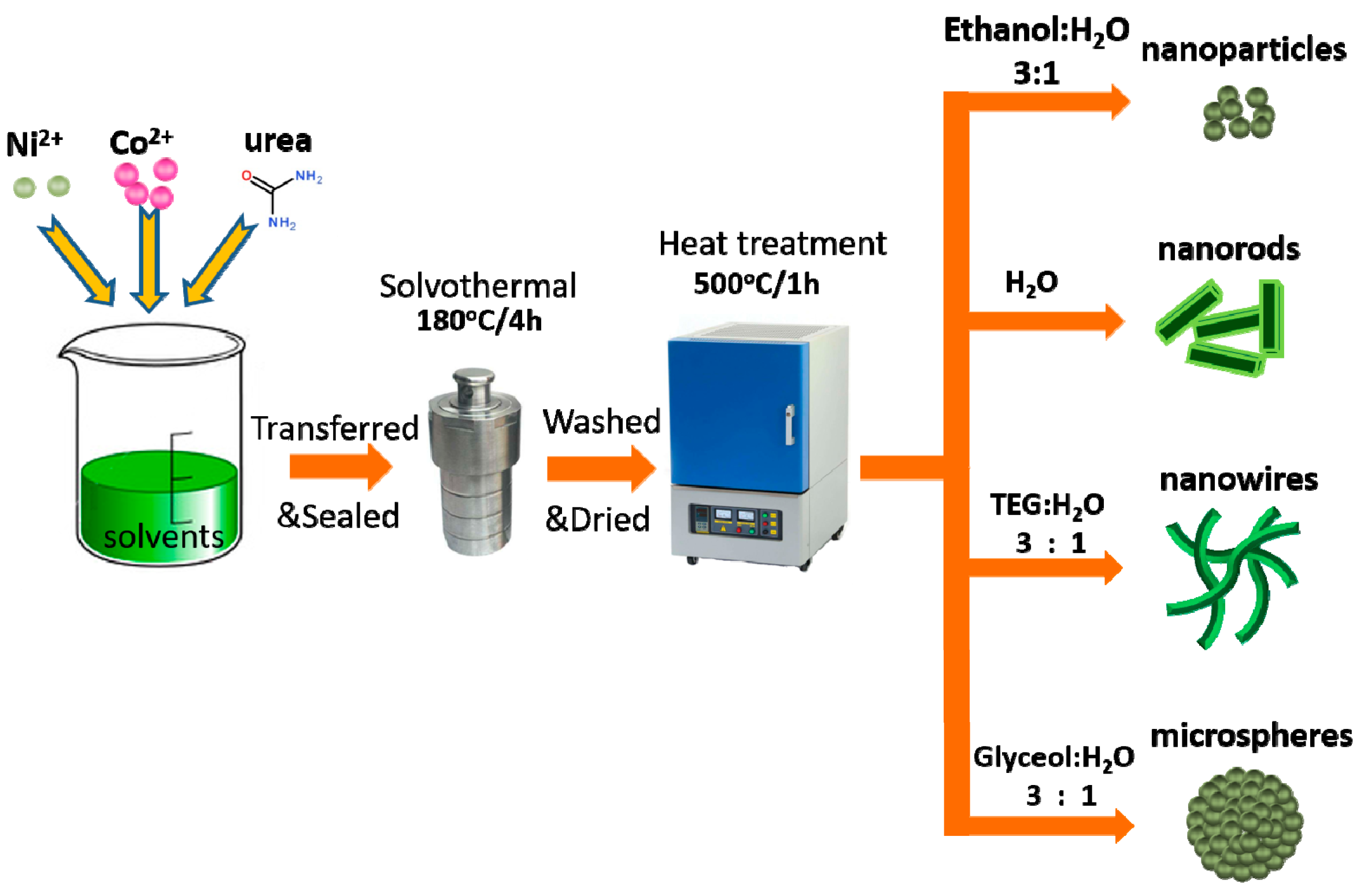

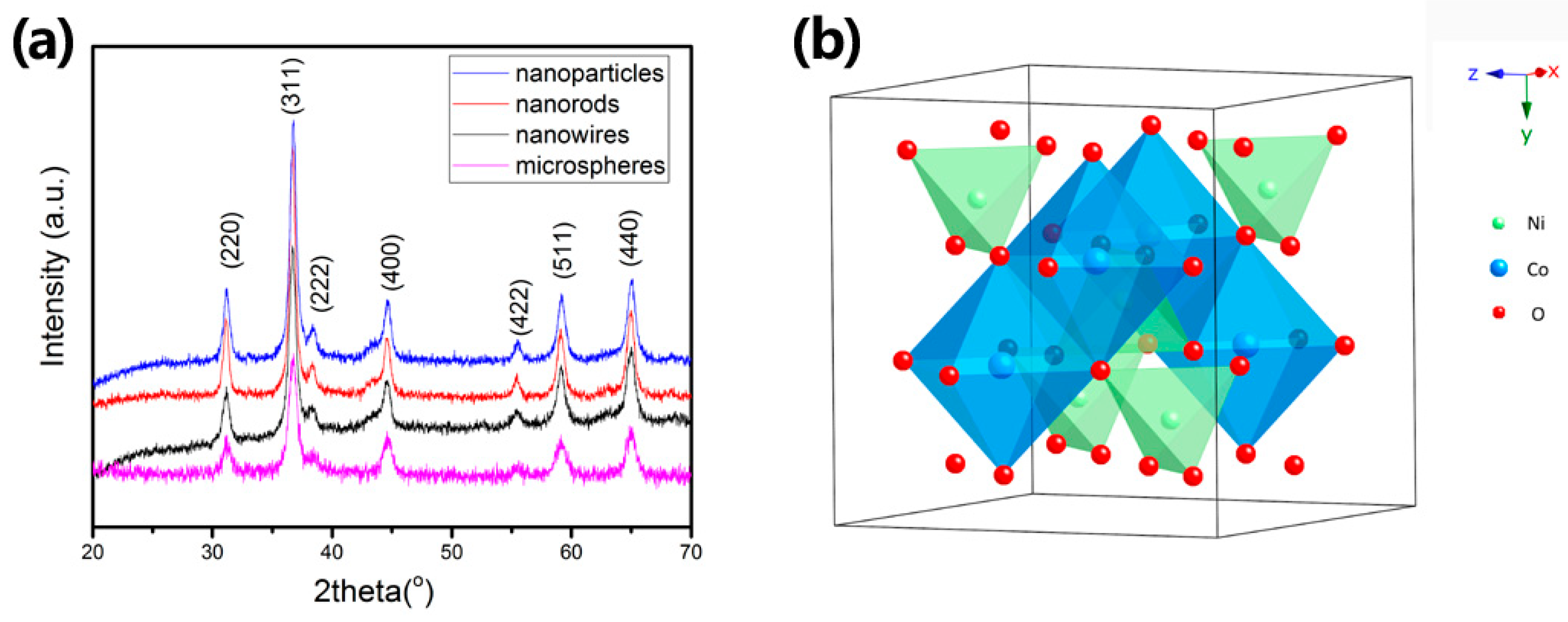
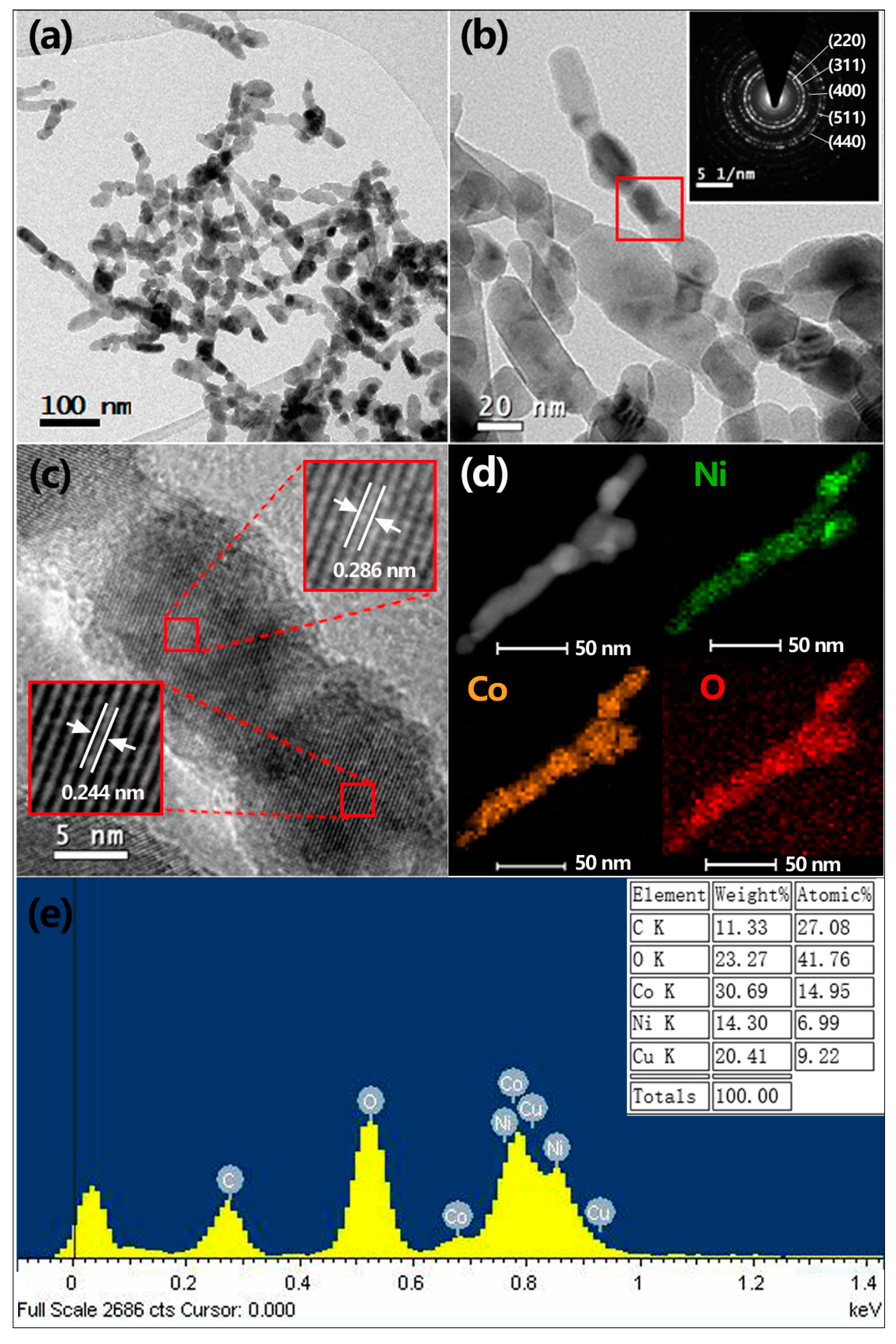
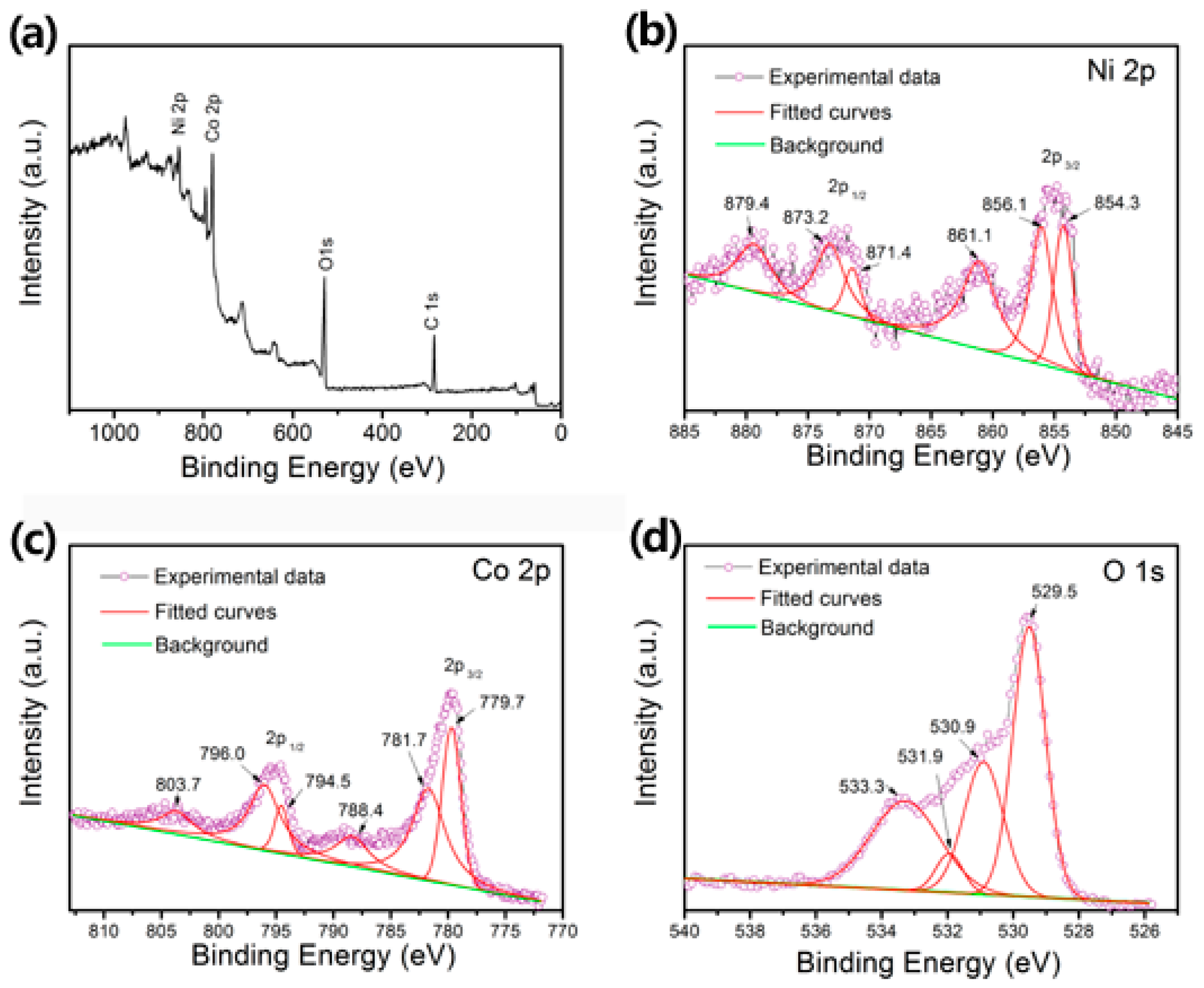
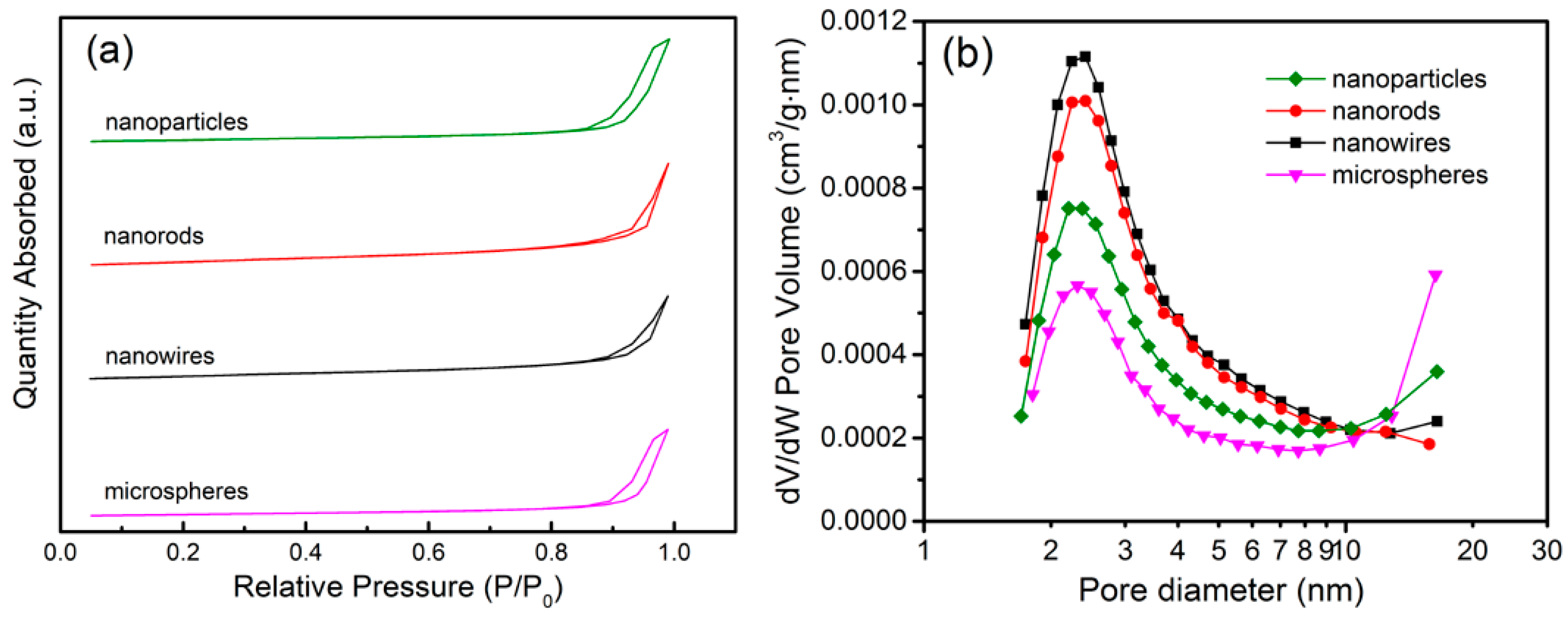
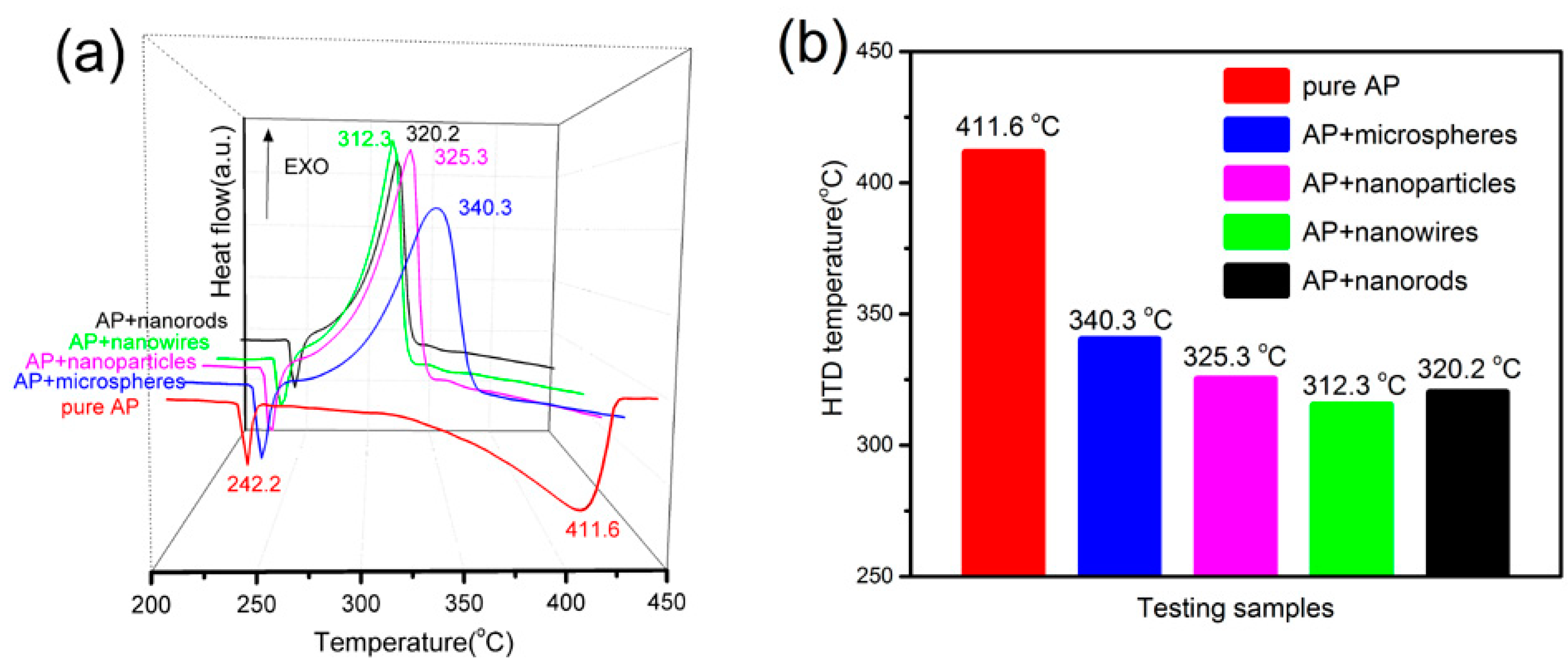
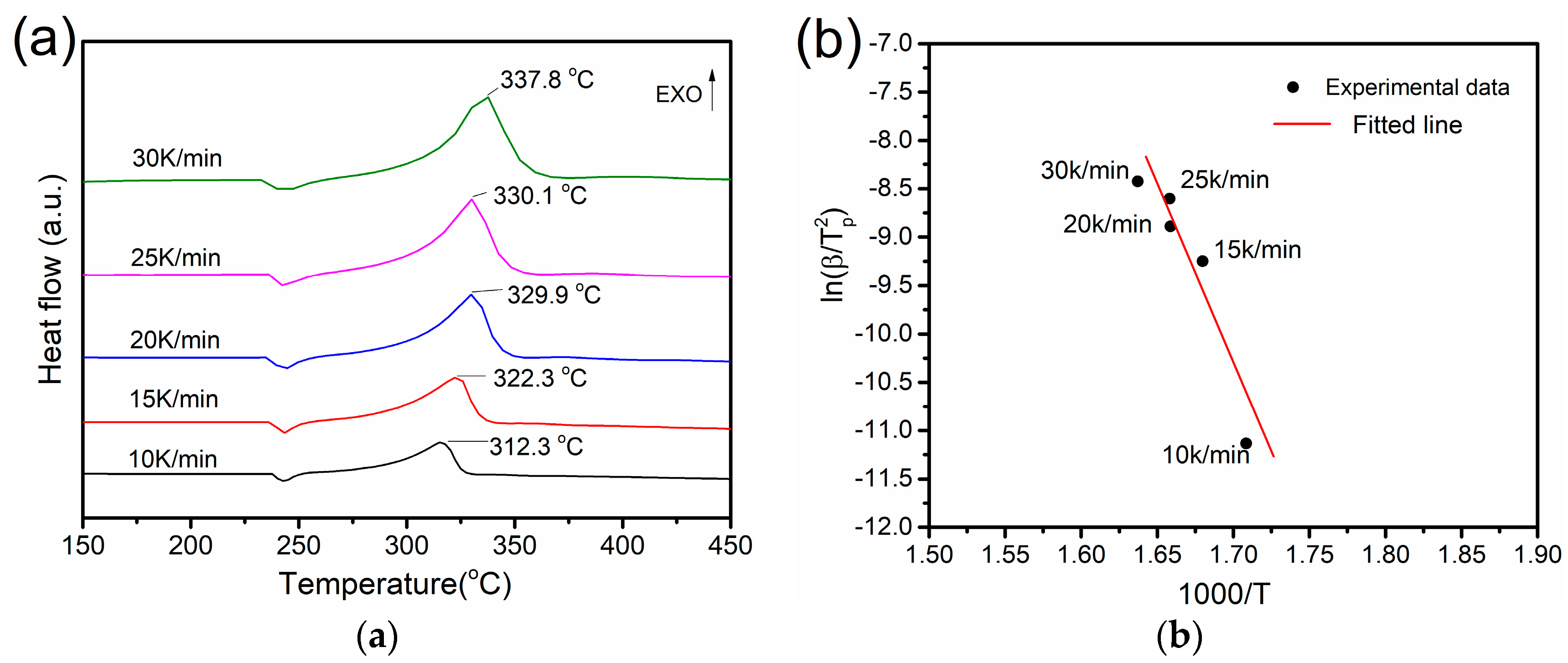
© 2019 by the authors. Licensee MDPI, Basel, Switzerland. This article is an open access article distributed under the terms and conditions of the Creative Commons Attribution (CC BY) license (http://creativecommons.org/licenses/by/4.0/).
Share and Cite
Guan, X.; Luo, P.; Yu, Y.; Li, X.; Chen, D. Solvent-Tuned Synthesis of Mesoporous Nickel Cobaltite Nanostructures and Their Catalytic Properties. Appl. Sci. 2019, 9, 1100. https://doi.org/10.3390/app9061100
Guan X, Luo P, Yu Y, Li X, Chen D. Solvent-Tuned Synthesis of Mesoporous Nickel Cobaltite Nanostructures and Their Catalytic Properties. Applied Sciences. 2019; 9(6):1100. https://doi.org/10.3390/app9061100
Chicago/Turabian StyleGuan, Xiangfeng, Peihui Luo, Yunlong Yu, Xiaoyan Li, and Dagui Chen. 2019. "Solvent-Tuned Synthesis of Mesoporous Nickel Cobaltite Nanostructures and Their Catalytic Properties" Applied Sciences 9, no. 6: 1100. https://doi.org/10.3390/app9061100
APA StyleGuan, X., Luo, P., Yu, Y., Li, X., & Chen, D. (2019). Solvent-Tuned Synthesis of Mesoporous Nickel Cobaltite Nanostructures and Their Catalytic Properties. Applied Sciences, 9(6), 1100. https://doi.org/10.3390/app9061100




